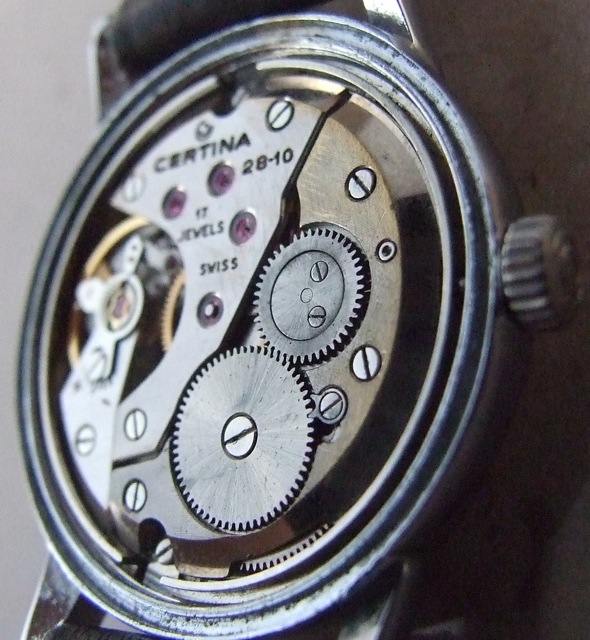Movements
(Picture credit: Certina Bristol 230)
A movement is the guts of a watch, the bits that tick. Or hum. Or make no noise at all. (That'd be analog quartz or mechanical, accutron and Spring Drive, respectively.)
ETA 28xx family
lysanderxiii wrote a fantastic post on the taxonomy of the ETA 28xx series, which feature heavily on this site. Here, I've reproduced his table with links to all of the movements I've researched so far. Go read his post please!
Note that most of these will be broken links as I work to add an entry for each.
From the post:
Around the late 1960s ETA began development of the most comprehensive movement families - the 2800 series. This family was to eventually supplant all previous movements in ETA's range of men's three hand movements. The scope of the technical effort was impressive - all of these movements would share nearly half of their components.
The basis for the family would be the tried and tested 2750 and 2770, which were themselves evolved from the 2370/2375 by way of the 2600/2620 of the mid 1950s. The one thing that had exemplified this evolution was the continual simplification and reduction of parts, especially small energetic parts like springs. These small springs were incorporated into the larger part they were to act on. Also, extensive use of formed sheet metal replaced costly machined parts. This allowed the manual wind, no date calibers to have an extremely low part count, only 43 parts, the most complicated the day-date automatic had only 75 parts, compared to the contemporary Omega 1000 which has a third more parts (102 total parts, seven of which are tiny U springs, and nearly twenty are small screws.)
The 2800 family consisted of a manual wind and an automatic line, each available in one of three speeds 3 Hz, 4 Hz and 5 Hz (21,600, 28,800 and 36,000 bph), two different sizes 11.5'and 13' (25.6 mm and 29 mm) and could have a date, a day-date, or no date display. The total number of possible configurations was 38, however, some combinations were never assign caliber numbers as the market would not support them, but could have been assembled from available parts. The total number of calibers in the family was 35. Between the manual wind no-date and the automatic day-date, if the frequency and size were the same, only 10 parts could not be interchanged.
There were six mainplates, a no date version, a date only version (later the no date mainplate was dropped and the date version was used on the no-date calibers) and a day-date version (which was a half mm thicker) in both 11.5 L and 13 L diameters. To change speeds, there were three balance assemblies, one for each speed, along with an escape and fourth wheel (a different balance stop was also required, when that feature was present). There were four mainsprings, 2 for the all the manual versions and 2 for the automatic versions. A total of 27 parts were used in all 35 versions (or could be used to assemble all the 38 combinations); within a single complication, 90% to 95% of the parts were common, and within a single speed, 60% to 70% of the parts were common.
There were also a few minor improvements made to the day-date mechanism that wound up causing 5 calibers, the 2810, 2812, 2830, 2831 and 2832, to become the 2816, 2817, 2836, 2837 and 2838. And, the 2838 was also modified to have a day display at 12 oclock, which would become the 2834, this modification only added one additional part, the new day display wheel.
The 2800 series was, at the time of its design, the ultimate multi-application movement. However, even before the quartz crystal knocked the bottom out of the mechanical movement industry, certain versions of the family were failing to catch on, and only seven lasted long enough in production to see a -1 variant (2801, 2804, 2816, 2821, 2824, 2834, 2836), and of those seven, one never made it to the -2 (at least I have never actually seen a -2 version of the 2821, and I strongly suspect there are few if any examples of the 2816-2).
Type | Size (ligne) | Speed (inverse vph) | No date | Date | Day and date |
|---|---|---|---|---|---|
11.5 | 3 Hz (18,000 vph) | ||||
11.5 | 4 Hz (28,800 vph) | ||||
11.5 | |||||
13 | 3 Hz (18,000 vph) | None | |||
13 | 4 Hz (28,800 vph) | None | |||
13 | None | ||||
11.5 | 3 Hz (18,000 vph) | ||||
11.5 | 4 Hz (28,800 vph) | ||||
11.5 | None | ||||
13 | 3 Hz (18,000 vph) | ||||
13 | 4 Hz (28,800 vph) | None | |||
13 | None |
Offsite references
- 535 movements at The Metatechnical Cabinet
- Partial ETA and Seiko list
- PMWF list; excellent
- Ranfft database, over 4000 movements
- ETA technical documents and drawings
- Miyota specs
- Casio watch manuals
- Seagull movements and CAD drawings
- Chinese watch wiki
- Metatechnical, 477 movements
The list on this site
- Accurat K1
- ETA 2824
- ETA 2826
- ETA 2834
- ETA 2836
- ETA 2837
- ETA 2892
- ETA 2893
- ETA 6498
- ETA 7750
- Miyota 8203
- Miyota 8205
- Miyota 8215
- Miyota 8217
- Miyota 821A
- Miyota 8245
- Miyota 9015
- Peseux 7001
- Quartz movements and sources
- Rolex 3135
- Rolex 4130
- Ronda R150
- Seiko 4S15
- Seiko 6R15
- Seiko 6S37
- Seiko 7S26
- Seiko 8L35
- Soprod A-10
- Vaucher VMF5300
- Venus 175
- VMF 3000 and 3002
- VMF 4000
- Zenith El Primero
